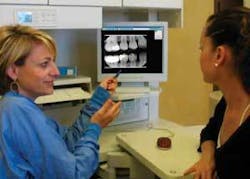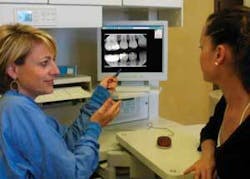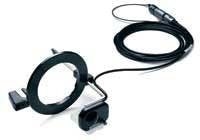The positive patient experience
Since many people equate a trip to the dentist with discomfort, we, as dental professionals, are challenged to make visits with us a positive experience. Part of creating a positive experience is eliminating patient discomfort, which, in turn, helps to create a stress-free environment for my patients, my team, and me. For this reason, I have incorporated such new technology as lasers, air abrasion, and anesthetic delivery systems.
There is one area where I believe we’ve fully succeeded in creating a positive experience for patients: digital radiography. We all know that film, a tool we use continually throughout the day, can be uncomfortable at best. With the addition of digital X-rays into my practice (Figure 1), I find that my staff is able, and grateful, to deliver positive intraoral X-ray experiences to our patients. But how did we get to this point?
When digital X-rays first came out, the premise made sense: lower radiation, instant images, enhancements, and other useful tools. I noticed that the systems emulated film - that is, there were different sized sensors to correspond with film sizes, and the shapes were like that of film with the sensors being slightly larger and having square corners.
As I continued my research, I spoke with colleagues who purchased these early systems. They conveyed to me that while they and their patients absolutely appreciated the instant image, they were still having patient comfort issues. Patients complained that the corners of the sensors poked their tissues. Team members were frustrated because now they were unable to bend the edges to achieve some relief for patients. Another staff complaint was the complicated accessories that came with their multiple-sized sensors. While the idea of several sensor sizes seemed like a good one at first, my team viewed it as twice the work. After all, another reason for going digital was to save time and effort.
So I continued my research, hoping to find a system that was more comfortable for patients and easy for my team to use. That’s when I ran across a 1999 study by Reality. It featured one system that was rated more comfortable than film and other sensors. The sensor was rounded on all four corners (Figure 2). This made sense to me, and it was a single-sensor system! I definitely wanted to know more.
I scheduled an in-office demonstration during which we took X-rays on each other. While all the other systems delivered an instant image, I learned firsthand that this single-sensor system went further. It allowed me to take any exposure, anterior and posterior, even in a small mouth - all with comfort. The system used one sensor with fewer holder changes than film, while still incorporating the standard RINN® technique that my team employs (Figure 3).
I chose this system because the company took a great technology and made it better. Right away, patients commented about how much more comfortable the sensor was than film. I knew I’d made the right decision in selecting a system that creates a more positive experience for my patients and less stress for those of us who care for them.Cynthia Brattesani, DDS, maintains a private practice in San Francisco. She won the prestigious ADA Golden Apple New Dentist Leadership Award in 1996. She is an enthusiastic member of organized dentistry, having held positions at the local, state, and national levels. You may reach her at [email protected].



